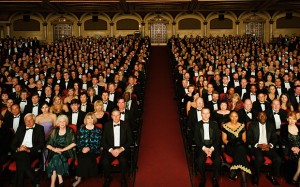 “The Program Era and the Mainly White Room” is a massively ambitious and provocative effort by Juliana Spahr and Stephanie Young to answer the question: Why is the space of American poetry still so white? This piece deserves sustained engagement, but here are a few of my thoughts from a very quick initial read.
“The Program Era and the Mainly White Room” is a massively ambitious and provocative effort by Juliana Spahr and Stephanie Young to answer the question: Why is the space of American poetry still so white? This piece deserves sustained engagement, but here are a few of my thoughts from a very quick initial read.
Like pretty much every poet of color, I’m sadly familiar with the “mainly white room” of the poetry reading/panel/conference/classroom that Spahr and Young describe. In fact, it’s not at all unusual for me to be the only non-white person in such a room. I remember a huge Bay Area reading—I think it was Alice Notley—in the early 2000s which was attended by hundreds of people. When I arrived, my first thought was, wow, I’ve never seen this many people at a poetry reading. My second thought was, wow, I may literally be the only Asian person here. (This is in San Francisco, remember—no demographic excuse.) The same is true of virtual spaces, like the good old Buffalo Poetics list, which I increasingly found in its later years to be not just a largely white space, but an aggressively white space, with a fair amount of casual racism and shouting down of nonwhite (and female) voices. (If you care, here’s my kissoff to the list from about a decade ago.)
I applaud Spahr and Young for focusing on the structural and economic issues that may have helped sustain the whiteness of American poetry, but let’s be honest: that phenomenon far predates the MFA era, and infects even areas of the poetry world that see themselves as oppositional to academic creative writing. In fact, I would suggest that the world of American “avant-garde” or “experimental” writing—the world I think that Spahr, Young, and I all share—has always been an especially white space, and has even been defined in opposition to the work of non-white writers, even as it often reaches outside mainstream white culture (to black bodies, to Asian literature) for its sources. So perhaps it is not so surprising that walking into a poetic space—even, or especially, an experimental poetic space—often to me feels like walking into a radically whiter space than the (still predominantly white) spaces I occupy in everyday life.
So the whiteness of poetic spaces is not puzzling, but constitutive: in American poetry, has it not always been so?
To my mind, the real question advanced by Spahr and Young’s analysis is whether the MFA system might have been, or could still be, a counterweight to this whiteness of poetry. The evidence they gather suggests that this has not been the case, and if anything that the economics of the MFA to date have exacerbated the whiteness of the poetry world. They also suggest that this does not have to be the case and that the MFA could be (radically) reimagined in a way to more consciously ameliorate poetic whiteness. But for me, since I don’t view the MFA as a root cause of this whiteness, I don’t see that reforming the MFA will decenter the whiteness of American poetry.
The part of the essay I’m particularly grappling with is the way in which Spahr and Young engage the question of “other” poetic spaces that exist outside of the “mainly white rooms” in which, in their account, most poetry discourse in the US occurs. There are several interesting moments where they describe their own efforts to find these spaces, only to come to the conclusion that they don’t really exist. The cultural nationalism of writers of color beginning in the 1960s is discussed largely as a phenomenon of the past, and the currently existing spaces that might be the most obvious places to point—the spoken word scene, institutions like Kundiman or Cave Canem—they seem to regard as too compromised or too closely linked to the MFA system. (I was surprised not to see a mention, for instance, of the Bay Area’s own Kearny Street Workshop, one of the oldest Asian American arts organizations in the country.)
What they are left with, then, is the prospect of “burning the room down from the inside.” This strikes me as a great way to articulate the project for progressive white poets. It also strikes me as a project that has increasingly less appeal for writers of color.
I don’t know if it looks that way to other people, but I would probably consider myself to be in the category that Spahr and Young call those who “walk away” from these white spaces. Although I’m an academic, I didn’t do an MFA and have always felt a bit at arm’s length from the poetry communities I wanted to join, and I increasingly found myself drifting away from the “poetry world,” at least as a poet (and even as a critic). It did, indeed, take finding a community of Asian American poets to help me return to poetry, and indeed to discover that one of my main interests—both intellectually and aesthetically—was critiquing the whiteness of modern American poetry. I’m not sure I can endorse Spahr and Young’s suggestion that this is an example of “segregation” in literary culture; the fact that more and more writers of color are opting out of the mainly white room is, to my mind, a productive development, and one of the few horizons on which I can see alternatives to the system Spahr and Young so incisively analyze.